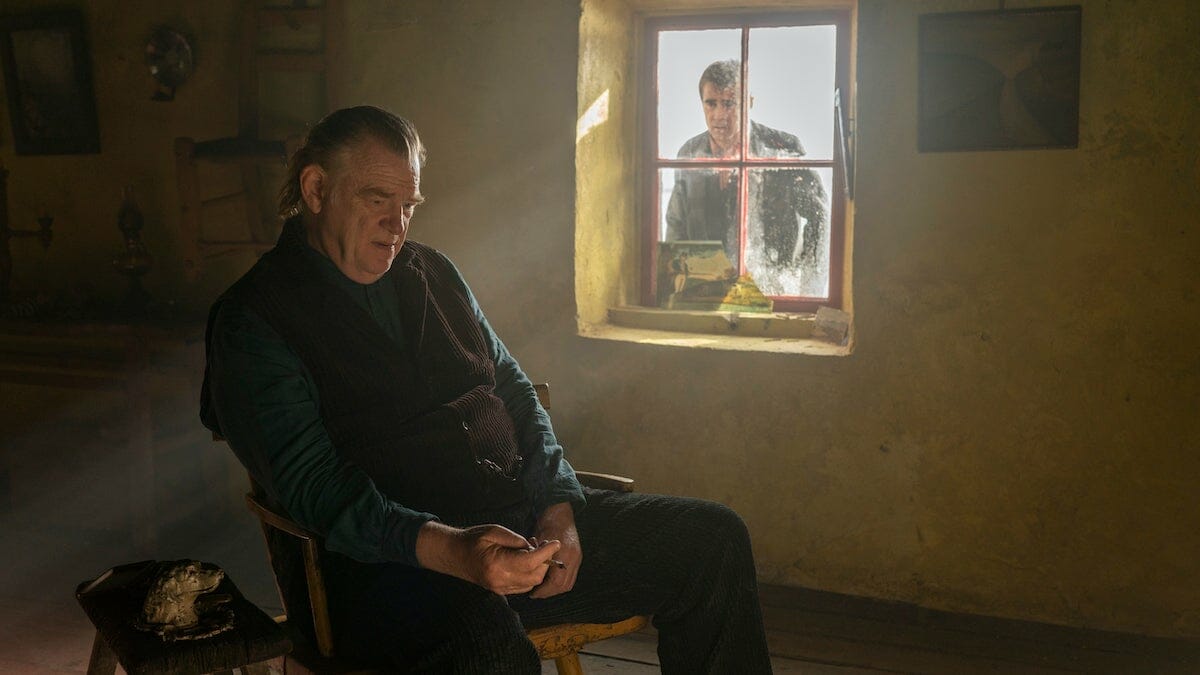The Banshees of Inisherin takes place in Ireland, which is a breath of fresh air not only because the island is green and gorgeous but also because Martin McDonagh, the film’s writer/director, has run into trouble in the states. His previous film, critical darling turned backlash defendant Three Billboards Outside Ebbing, Missouri, suffered from a shallow approach to American racism that could be charitably described as “clumsy” if the film weren’t so cavalier. Banshees, on the other hand, is no such cross-national commentary—it’s a vicious little comedy about a breakup between friends.
There’s more to it, of course; McDonagh has a playwright’s taste for allegory and an allergy to subtlety. In the foreground, two (formerly) close friends on the fictional island of Inisherin fall out when Colm, a sullen yet charismatic Brendan Gleeson, decides that he’s wasting his time by spending it with Pádraic, a heartbroken, extremely sympathetic Colin Farrell. While the two get into their tiffs—one baffled and desperate to reconcile, the other begging to be left alone—a larger battle plays out across the water, sometimes very loudly, prompting characters to remark things like, “well now, that’d be the Irish Civil War” and “why yes, the war between two sides who were once civil with each other.” There’s subtext here; I just can’t put my finger on it.
READ ALSO: New Rob Schneider film ‘Daddy Daughter Trip’ is a love letter to Arizona
READ ALSO: Read all of Ryan Bordow’s movie reviews here
Outside the metaphor, the tension between Colm and Pádraic is hilarious and affecting. Gleeson and Farrell—reuniting with both each other and McDonagh for the first time since In Bruges—luxuriate in the writer’s stark yet rhythmic sense of humor, dancing through wordplay with a controlled, extemporaneous fluster that makes the blunt punchlines hit harder by contrast. And rather than doom the pair to caricature, the script complicates its absurd setup with a very real friendship, making room for the regret, longing, and agony of irreconcilable difference. It’s that carousel of gut-busting and gut-wrenching that only the best black comedies achieve.
The soft, diffused lighting and lush greenery of the setting, shot handsomely by cinematographer Ben Davis, cast a drowsy, mythical glow that, in concert with references to Irish folklore, gives the tale the feel of a perverse parable. Its most expressive shots are little tragicomic metaphors, like Pádraic and Colm, newly broken up, sitting just feet from each other but separated by a wall and framed through a window. The visual language is tight and illustrative. The larger war metaphor, though, hangs on the conflict a bit loosely.
While the film nails the inexorable friction of ideological difference—what is coexistence but temporary compromise? —and the attendant feelings of awkwardness and loss, personal enmity is but a drop of oil in the war machine, and the film is less interested in allegorizing institutional and cultural forces. In other words, Banshees captures (and skewers—and mourns!) the kind of fraternal tension that would contribute to civil war, but it’s too insular to allegorize the specific fraternal tension of civil war. This more incidental connection isn’t a bad thing, but it makes the persistent obviousness of the metaphor feel overeager.
Still, overeager can be endearing, as Farrell is set on proving. His performance as simply genuine and genuine simpleton Pádraic is a career highlight. He’s a ball of anxiety next to the hotheaded Colm, and he sells the nervous depths of sensitivity with comic grace and dramatic heft. Gleeson is a legendary actor, but when it’s Farrell who delivers the line that ties the themes together, you’ll feel McDonagh made the right choice. Not that he could’ve gone wrong—again, this is the In Bruges duo.
Along with Bruges, The Banshees of Inisherin is a serious contender for McDonagh’s best—and his funniest. It certainly has one of his strongest rosters of side characters, not least perpetual weirdo Barry Keoghan, who’s right at home in this off-kilter circus of violence and affection. The film may not be an allegorical masterwork, but it’s still a hysterical portrait of the pains that last through history. Sometimes political messaging is better off sublimated, even if it’s a little obscured.
★★★★ (4/5)




